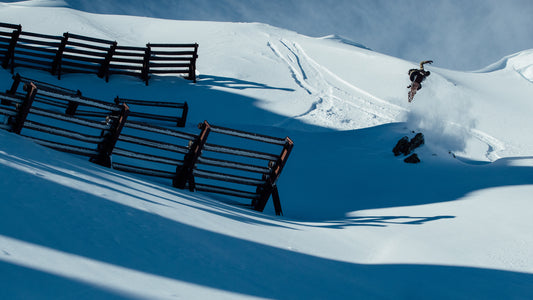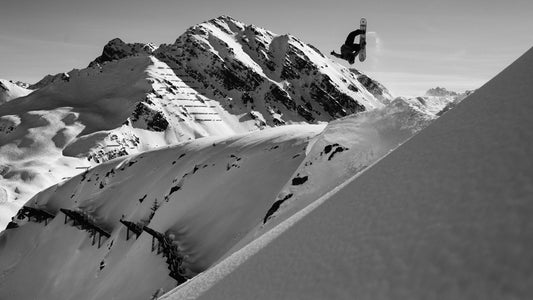Sizing, heat molding and breaking in explained

When it comes to the perfect snowboard boots, fit is everything. Period. Your boots will only perform properly if they fit properly, so keep the following tips in mind when you’re trying on your next pair:
Are snowboard boots true to size?
Not necessarily. Just like regular shoes, a US size 10 from one brand can come up a little bigger or smaller than the next brand. The difference with snowboard boots is that it’s even more crucial you find the right size (which means forgetting any assumptions when you walk in the store).
We recommend measuring your feet in millimeters (aka Mondopoint sizing) when trying on boots from a bunch of manufacturers. Since Mondopoint is standardized you should (in theory) find less variation. Check out our snowboard boot size chart to get a feel for how the conversion works and choose the best snowboard boot for you!
How tight should your snowboard boots be?
Snowboard boots need to be a snug fit across the whole foot; it’s not like sneakers where you can get away with a pair that are a little roomy. When you first put your foot into a brand new snowboard boot, you should feel your toes gently touch the end of the liner. It shouldn’t hurt (you don’t want them to be bunched up or crushed at the sides) but equally, you don’t want any spare space at the end. A little wiggle room upwards is OK.
Once the inner and outer boot are laced up, try bending your knees as if you’re in your regular riding stance; at this point, you should feel the toes come away from the end slightly, and you should not experience any heel lift. If all those boxes are ticked then you’ve found the right size snowboard boot! And never forget, a comfortable snowboard boots is all that matters when you ride.
How to heat mold snowboard boots
The liner is the heart of every snowboard boot. While the outer shell dictates the overall look, as well as providing support and protection from the elements, it’s the liner that determines the fit.
At Rome, our goal is to produce the most comfortable snowboard boots on the market. We therefore deploy heat moldable liners in every model, which become tailored to your individual feet. This can be done in store with the help of a professional snowboard salesperson, or just by cranking your boots tight and wearing them around for a while; your body heat will soften the foam, which gradually adapts to the shape of your feet.
If you’re brave and you want to speed up the process at home, you can even remove the thermal liners and carefully warm them in your oven. Just be sure to use a low heat and don’t leave them in there for more than a couple of minutes! Once they’re warm, stick the liners back in the outer shell, lace up and stand in your boots for 5-10 minutes as they cool down.
Don’t expect the liners to miraculously shrink if they are too long and/or wide in the first place. Likewise, heat molding won’t fix an initial fit that’s painfully tight. The idea is to take a boot that feels pretty good out of the box and add that finishing touch.
How to put on snowboard boots
It might sound like common sense, but how you lace your boots is crucial to their fit and performance – and there’s more than one way to do it.
The first step is always tightening the liner, for the simple reason you can't reach those laces once the outer shell is tied. Crank the harness down enough to secure your ankle, but don’t go crazy or you can wind up with pressure points and limit the circulation.
At this point things become a little less obvious. Whichever lacing system you prefer – BOA, regular laces or a hybrid – Rome’s outer boots can all be divided into two zones (lower and upper) which you can adjust according to your personal preference.
The lower zone (around the foot) is all about precision and control. The upper zone (around the shin and calf) fine tunes the flex and generally dictates how much you can lean into the boot.
- If your riding style is all about quick spins and jibs on smaller features, a tight lower zone combined with a more relaxed upper zone might be the way forward. It gives you the control to initiate rapid maneuvers while letting you express yourself by tweaking around.
- If you enjoy going fast – blasting the groomers, charging backcountry lines or hitting big jumps in the park – you’re probably best to keep the laces cranked from top and bottom. This will provide you with more response when turning and braking, and more support to help you soak up heavy landings.
- If you’re looking for a mellower feel and just want to cruise for a while, it can feel good to loosen up the foot area while keeping the upper zone pretty tight. You’ll still have plenty of edge-to-edge response but doing this can reduce foot fatigue.
Breaking in snowboard boots
Even the most comfortable boots in the store can be a little painful when you first ride in them. Most new pairs need to be broken in, which basically means giving them time to adapt to your individual foot shape and to fit snug inside your bindings (it can help to use boots and binding from the same brand here).
The best advice we can give you is to wear your boots at home before you go shredding for the first time. Get familiar with the lacing, the flex and the general feel while you’re walking around the house and getting on with your day. If you’ve not already done so, you should definitely take the time to heat mold the liners (see above) – this is the single quickest way to speed up the break-in process.
If you still have any pain after a few days riding, it might be worth thinking about a custom-made insole, though that is unlikely to be necessary with Rome’s F.I.T liners and performance footbeds, which are designed to offer maximum comfort out of the box.



